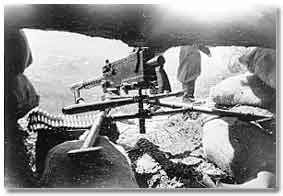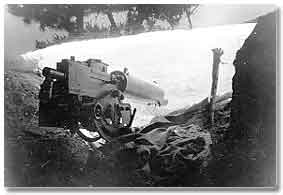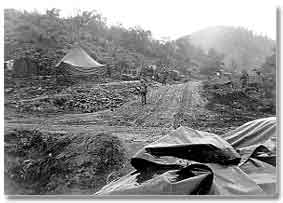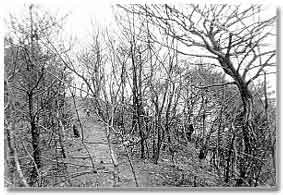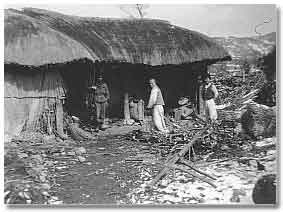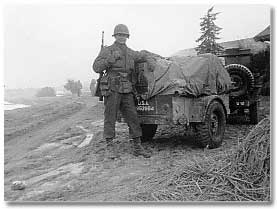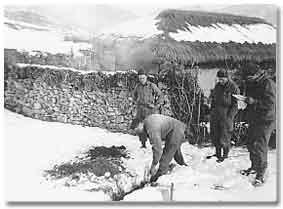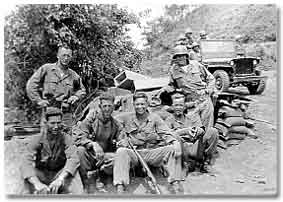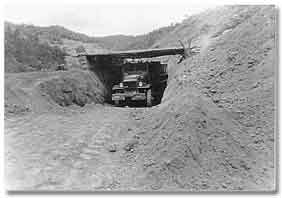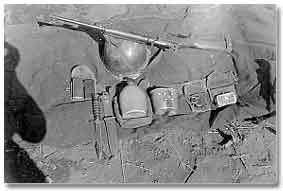|
We need your help to keep the KWE online. This website
runs on outdated technology. We need to migrate this website to a modern
platform, which also will be easier to navigate and maintain. If you value this resource and want to honor our veterans by keeping their stories online
in the future, please donate now.
For more information, click here.
|
||||||||||||||||
 |
||||||||||||||||
| Back to "Memoirs" Index page | ||||||||||||||||
|
|
Michael NjusLawler, IA- "For him, the hardest part of basics was the forced marches, five and ten miles long. "It was October," he recalled, "but it was still very hot and it seemed to just wear everyone out." Njus said that even after eight weeks of training he did not feel he was ready for combat. But World War II was over, and no one seemed concerned..." - Michael Njus
|
|||||||||||||||
|
||||||||||||||||
Memoir Index |
||||||||||||||||
Background Information
New RecruitNjus’ trip to basics started at Waterloo, Iowa, where he boarded a train for Fort Snelling, Minnesota. He was sworn into the Army at Ft. Snelling, and then sent by train to Fort Sheridan, Illinois. At Sheridan, the new recruits were processed and given physicals and aptitude tests. When processing was finished, the men were sent by train to Louisville, Kentucky. Army buses from Fort Knox met them and hauled them to the training camp. After forming ranks in a very sloppy manner, the new recruits were marched to their barracks area. The barracks were two-story, World War II-vintage, wooden structures. Njus was assigned a bed, locker, open clothes hanger and shelf on the second floor of the barracks. In the supply room, recruits drew sheets and blankets for the beds, and then the sergeant in charge showed them how to make up the bed military-style. Basic training was eight weeks. Daily training started with marching and close- order drill. They learned how to take the M-1 rifle apart and put it back together again. After they became proficient with the care and handling of the gun, they went to the firing ranges and learned proper firing techniques. They learned to shoot in different positions, firing at targets at 200 yards out to a maximum of 500 yards. In addition, they went on long marches to toughen them up. They also participated in classroom training on the care of equipment, military courtesy, Army regulations, and health care in the field. They heard lectures on VD and its many dangers. The day began at 5 a.m. by the platoon sergeant snapping on the lights and hollering "reveille" and other words to shock them awake. They had 15 minutes to get dressed and fall out for reveille formation and roll call in front of the barracks. Then they were dismissed to shave and wash up and be ready to march in to the mess hall for breakfast. Prior to breakfast, they also had to make up the bunks, scrub the floor, and police (clean up) their own area. After chow they had calisthenics for an hour, close order drill, and went on to a class in some subject. Most days ended at 5 p.m. except when they went on a night march or a night exercise. Lights out was at 10:00 p.m. Njus recalled that the instructors were only moderately strict, and there was no personal physical abuse. "The drill sergeants were the toughest," he said. "And that was for a reason. We had to learn to obey all commands immediately and without question." For the most part discipline was on an individual basis, but Njus recalled the time they didn’t pass Saturday morning barracks inspection. The punishment was restriction of the whole platoon. They had to scrub the whole barracks floor and latrine with hand brushes—AGAIN. "Someone probably didn’t have his bunk made up properly or clothes were askew on a hanger," said Njus. For him, the hardest part of basics was the forced marches, five and ten miles long. "It was October," he recalled, "but it was still very hot and it seemed to just wear everyone out." Njus said that even after eight weeks of training he did not feel he was ready for combat. But World War II was over, and no one seemed concerned, he said. Following a graduation ceremony that included marching in company formation in front of a reviewing stand, the troops were dismissed. Basic training was over and travel orders and vouchers were issued to get them to their next camp. Occupation Duty in JapanNjus was sent to Camp Stoneman for embarkation to Japan for occupation duty. He was assigned to "H" troop, 8th Regiment, 1st Cavalry Division. The base was in the Ropongi district of Tokyo, which was only 1½ miles from downtown. The soldiers in H troop lived in the barracks of the former Imperial guards who were the Emperor’s personal guards. Their main duties as a unit were to provide guards for various banks, warehouses, parks and shrines. Also, every other month they rotated with the airborne division to do duty as military police for the city of Tokyo. They patrolled with jeeps and also on foot. Mike Njus was assigned to the heavy weapons platoon, where he trained on handling and firing the heavy .30 caliber machine gun. He and others also trained on the .30 caliber air-cooled light gun. The instructors were company officers and noncoms, most of which had been in the Pacific war. The familiarization training was done in the company area on the base. For the actual firing training they used firing ranges out in the countryside. The men were then tested on firing the guns. Njus took first prize in a competition in his company and got a ten-dollar bill for a prize. Once they went on maneuvers for a week on the slopes of Mt. Fuji for combat training. Training went on the whole time he was in Japan. But there was leisure time, too. Njus had many opportunities to go on pass after working hours and on weekends. Since the camp was only 1½ miles from the "Ginza" or downtown Tokyo, it was easy to go to the GI spots there. One of his favorite places was the Ernie Pyle Theater—a very modern movie house. One weekend he went to a resort area at Kamakura, south of Tokyo. There were many small shops where the Japanese had many items for sale for the GI trade. Njus bought a string of pearls and a diamond ring and silk kimonos to take back home. The Red Cross had a club down town that was a very popular place to spend time. There were always doughnuts and coffee for free, along with access to pool and ping pong tables. Njus recalled that the damage to Tokyo from the fire bombing that ended World War II was very extensive and still evident. Miles and miles of the residential areas were all destroyed, with only house foundations and an odd chimney here and there standing to show where houses once stood. The downtown area and the Imperial Palace, however, did not seem to have been hit. He said that the attitude of the people was one of defeat and despair. They were very docile and were subservient to anyone in uniform. They tried not to do anything that would upset a GI. Food was very scarce for them so they would go through the base garbage cans looking for anything to take home. This was forbidden by the Army, but most of the guards just looked the other way. GIs used the laundries that many Japanese operated in their homes. "They did a super job washing and ironing our fatigues—our work clothes," recalled Njus. They also had photo shops where he had many of his films developed. For a period of 12½ months (December 24, 1946-January 7, 1948), Njus was stationed in Japan. During his stay there, occupation troops were conducting war crimes trials of the top Japanese army generals and high government officials. One of the highlights of his time and tour of duty in Japan was when he got a pass to attend the trials. After following the accounts of the war for five years, he was interested in seeing some of the Japanese who had been in the news. The trials were held in a huge courtroom in Tokyo. He remembered seeing General Tojo, who had been the premier of Japan for a while. Some Japanese on trial were civilians who were high in the government and the rest were military men. There were about fifteen in all. He said the judges in charge of the trial were all civilians and were from or represented the Asian area that the Japanese had captured at one time. Njus remembered Australian, British, and American judges, too. The prisoners were very docile and reserved, isolated in an area like a box with low walls. Security was tight, and the prisoners were all guarded by 8th Army military police in more than sufficient numbers. They were transported back and forth from the trial to Sugamo Prison under heavy guard. On the day that Njus attended the trials, there seemed to be a lot of procedural matters being handled. All the prisoners had headphones on to follow the procedures. Public observers were given some kind of program when they entered the courtroom. While in Japan, one of the assignments given to Njus was to be part of the guard detail to take eight Japanese army officers by train to the port of Kobe for their return to the Philippines. They were sentenced to be hung there. One was the general that was called, "The Tiger of Manila." At Kobe they were put on a ship to finish the trip. When his time was up in Japan, Mike Njus returned to the States on the General McRae. After docking in Seattle, returning troops went to Fort Lawton to process out and be discharged. At that point, Njus joined the inactive reserve for a three-year period. He figured that the country would soon be at war with the Russians. At the time he was discharged from the Army in January of 1948, the Russians were causing trouble in Europe—Berlin in particular. The Berlin blockade and the resulting Berlin airlift were just some of the problems the Russians were involved in at the time. "I figured they would push us until we had an armed conflict in which I would be recalled and be involved in," explained Njus. Since he had no combat time, he felt he would be recalled quickly if they needed men. "I wanted to preserve my rank of sergeant," Njus explained. "NCOs did not have to do duty details such as walking guard and doing KP. I also wanted to preserve my pay grade. Two years and eight months later I was recalled back to fight in Korea. During the interim, I returned home and enrolled in a trade school, studying air conditioning and refrigeration. A year and five months after returning home, I married my high school sweetheart, Betty Jean Zweibohmer. We lived in Marshalltown and Des Moines, Iowa, where I was working as a sheet metal worker until I was recalled in August of 1950." Korean War Breaks OutWhen the Korean War broke out, Njus heard about it on the radio and then read about it in the newspapers. "I was most interested since I still had over a year to go on my three-year enlistment in the reserves," he said. "I do not remember exactly wanting to go to war, but it had a mystery and excitement about it. Until you hear a shot fired at you, war is just an idea or a fantasy in your mind." Njus continued to be very interested in the events happening in Korea, and he tried to get all the information he could about it. Most of the news was by radio and daily papers, with an occasional magazine. "I had a feeling that I would be getting a notice that they needed me," he said. His parents were very concerned and worried about his call up. Meanwhile, Betty Jean—who had been married to him less than two years--was a very typical newlywed in that she didn’t want her husband going off to war. "I know she was worried all the time I was gone," said Njus. For Njus, he was apprehensive about the war breaking out. There were America troops there, and Njus said, "Each day it seemed like the North Koreans were clobbering them along with the ROKs." As each week passed, he said it seemed as if the Americans would be shoved right off the Korean peninsula. "I felt very bad about the beating the GIs were taking," said Njus. Although Njus was a reservist, his recall situation was that of an individual rather than a unit. When recalled, he was sent to Fort Hood, Texas for thirty-day refresher training. The training was mostly to get the troops into shape and to see what individual capabilities were available. Njus’ MOS was for a machine gun squad leader. "During the initial processing, I could hear the processors discussing where I should go for refresher training, recalled Njus. "Since I was discharged in 1948 from the 1st Cavalry Division, and they assumed the Cavalry was now an armored outfit (wrong!), I should take training in tanks. I had never been in a tank before. I lucked out in that the tanks we were to train on were the new (1950) M-46 Patton tanks. None of the real tankers had ever seen them either, so we were all greenhorns. Actually, it was very interesting and I enjoyed it immensely. The infantry, where I should have been, were taking five and ten mile marches to get into shape." After "refresher", the troops were shipped out, but not as a unit. It was more like a loose group to be assigned when it got to Korea. Training was cut short to around 24 days. When his recall came, Mike and Betty Jean Njus were living in Des Moines, Iowa, where he was working as a sheet metal worker. "We moved all of our furniture and other items to my parents’ home. My wife made plans to live with her parents. I’m sure she was very sad and apprehensive about my leaving. We had just bought a new car so she had good transportation. I spent my last week at both parents’ home. The goodbyes were said there," he remembered. Off to WarNjus left home for Fort Hood on September 16, 1950, and left the USA from Camp Stoneman, California, on October 17, 1950. He made the trip to Korea in a troop transport holding some 3,500 men. Njus volunteered for mess detail on the ship, and got a job moving food from the refrigerated holds up to the galley four or five decks above. "This was great since we could get apples and oranges to eat whenever we wanted them," he said. "It also helped to pass the time." Somewhere between Hawaii and Japan, they ran into a typhoon or the edge of it. It got very rough, making it hard to walk or do anything at all. Troops were not allowed to go up on deck at any time. Because of the rolling ship, the Army mess sergeant for the ship was killed when he was thrown against a bulkhead. The swells also caused increase seasickness--a fact of life onboard a ship. "I was lucky in that I had the third bunk up and a well guy above me in the fourth," said Njus. It took 15 days to get from California to Osaka, Japan, by way of Hawaii. The ship sailed in and out of Pearl Harbor without stopping. Instead, it continued on to Osaka, Japan, arriving on October 31, 1950. The troops were off-loaded and went to a replacement depot. They were processed for their general destination, and issued weapons, ammo, and other field items. The next day they were loaded onto large ferryboats, each holding about 500 men. The ship on which Njus was assigned took a southern course around the south end of Japan and the south end of Korea, finally landing at Inchon. Njus said it seemed like a two-day trip from Osaka to Inchon, with the ship arriving in the forenoon. Since the tides at Inchon rise and fall fourteen feet, the ferry had to anchor two miles from the docks. Troops off-loaded into smaller landing craft-type boats for the final leg of the trip. "Before we all got unloaded," recalled Njus, "the tide was starting to ebb. The boats had to sit on the mud until the water came back. When the tide was out Inchon harbor was a mud flat for a mile and a half out." From the ship, Njus observed that Korea seemed to be not very built up or advanced. The docking area was a mess of supplies and men moving around the ruined harbor facilities. The area was very dirty. "As soon as the dock area came in sight, we could see shelled buildings and homes," said Njus. "Also, on some islands in the harbor there were artillery guns that had been blown up. It was definitely a war zone." New at CombatWhen he arrived in Korea, Njus had not been assigned to any unit yet. The troops were loaded into Army 6x6 trucks that took off for the north. The trucks went through Seoul, then northwards through Kaesong and on to Pyongyang. At a replacement depot along the way, he was assigned to the 1st Cavalry Division, 8th Regiment as squad leader in a D company machine gun platoon. The 8th Cav was located near Sunchon, about 40 miles north of Pyongyang when Njus joined them. They were in a holding position at the time, maybe to get replacements for the depleted squads. "Around Seoul and Inchon the refugees had started to come back," recalled Njus, "and I think many were hired help with manual labor tasks around the many units there. As we got further north, they thinned out. In our regimental area, only a few who were with us were visible. Anyone else could be assumed to be a guerilla and shot on sight. At this time there were guerillas in the hills around us, so care had to be taken not to be surprised by them." About three weeks after he joined his unit, Njus saw his first enemy. That was the time they started their big push in earnest. Most of the enemy action was probing attacks at night, since the American air force was very effective in keeping them under cover during daylight hours. During this time, the company was running patrols up the road to their third battalion, which was on a forward outpost duty. Njus joined the company about November 5 or 6, and for the next couple of weeks the whole unit moved forward slowly. Later they found out that the Chinese had crossed the Yalu River on the 2nd of November. "They hit us in force two days after Thanksgiving Day, destroying our third battalion," Njus recalled. "The rest of us bugged out in retreat for the south." The situation at this time was that they did not have a front line as such. "We ‘owned’ the valleys and the roads and any villages on them. The gooks owned the hills and high ground," said Njus. As a result, there were always guerillas behind them in the hills. "But for me," recalled Njus, "those first days were rather uneventful and I neither saw nor heard any enemy fire." In fact, during the early days of his stint in Korea, Njus considered being in a new country and in war a novelty. He said, "When I first got there it was still a great adventure, and since there was no real fighting, there wasn’t much to worry about. My first fear came when the Chinks hit our third battalion, and we didn’t know what, where, or who. There was great confusion and chaos. We were trying to load all our supplies and troops onto trucks and jeeps to get out of there, and we were burning everything else. If a vehicle broke down, it was shoved off the road and set on fire." Njus carried a .30 caliber M-2 carbine during the war. The M-2 could fire single shot or rapid fire like a machine gun. He generally carried two magazines that held fifteen rounds. Later they got magazines that held thirty rounds. He was pleased with his job as squad leader, but he, like others in the company, didn’t like the company commander. "Everyone in the company thought he was crazy," explained Njus. "He seemed to be unsure of himself and was giving conflicting orders or just plain crazy ones. Sometime after we had stopped retreating and turned around, he was relieved of his duty as commander." According to Njus, the company C.O. seemed to be unsure of their part of the defensive perimeter. "We would be changed from one set up to another, which didn’t seem to make much sense. I recall our platoon sergeants were not at all happy working with him. Since I was only a lowly squad leader, I did not have much contact with company headquarters, so my personal feelings were formed by what filtered down." All the green troops newly arrived in Korea had to become accustomed to a very new type of living situation. "Everyone was trying to do their job and get along," said Njus. Several veterans of the Pacific campaigns were in the company. "They knew their stuff and were good leaders," recalled Njus, "but they seemed to be burned out. Most of them were in their late 30s or early 40s, and to me they seemed old. I’m sure they were staying in the Army to get retirement and were swept into the war when their units were sent to Korea." There was a different kind of "old-timer" in the company as well. They were veterans who had been in Korea for four months, and who had been in on the first fall-back to the Pusan perimeter. A high percentage of those veterans were from three to five years younger than Njus. They taught him things of a procedural nature. A large part of his "on the job" training was setting up defensive positions and trying to get adequate rifle protection on their flanks. Njus said that he didn’t know when a person got "enough" training. "I’m sure we could have had more, but time and money costs probably dictated how long the training programs went. When you get into combat, you sort of learn ‘on the job’. All you have to do is stay alive to learn." He said another part of the ‘learning’, "was the personal things: shaving with cold water, bedding down at night, keeping dry, eating when you could, and sleeping while sitting on top of a loaded trailer while on the move." And there was a lot of moving. In the first three months of his time in Korea, Njus recalled moving north, and then back down south. "We went from 20 miles south of the Yalu River to 50 miles south of Seoul when we were kicked out of the north," he said. Most of Korea is low hills or high mountains. In traveling them, he noticed that most of the vegetation at that time was scrub brush not over 15 feet tall. Most of the large trees had been cut and used for firewood. In the north, when his unit was very mobile, they didn’t have any permanent positions. His regiment was located about 20 miles south of the Yalu, but the outpost was three or four miles ahead, or further north. "Our battalion would on a periodic schedule send a weapons carrier (three quarter ton truck) with a .50 caliber machine gun, a light .30 caliber machine gun, and a squad of five men (with driver) from the battalion area, up the winding road to the outpost. The purpose was to check for road blocks set up by the gooks. They would set up on the hillsides on both sides of the road and try to disrupt or destroy any traffic on the road. There were no roadblocks in this area at this time. This was just before the Chinese started their all out attacks on all fronts." "After the big ‘bug out’ or retreat from the north and we turned around and started back," Njus said, "we did dig in and used temporary cover. As the going got tougher and our attack momentum slowed down, we went to bunkers, foxholes, machine gun and mortar pits. After the turn-around, we kept pushing all the time, so we never had any permanent positions. There were times when we would be static for two or three days at a time. This was to get geared up for another push. The procedure for our advance was to rotate the attacking battalion, so there were reasonably fresh, rested, and fully-supplied men to keep the attack moving. The system was to have one battalion on the attack and two in reserve." He remembered his first firefight or "baptism of fire" clearly. "My first firefight came after we stopped the retreat and turned around. As a machine gun section, we gave covering fire for the riflemen as they advanced. The chinks were dug in on the slope of the hill, so they had to be thrown out hole by hole. The return fire was my first time under enemy fire." At night they went into a defense mode. "Our guns were dug in and there were riflemen on each side of us for protection," he explained. "Mostly the UN troops fought in daylight hours and the Chinks would attack at night." When the company turned around, it was about 50 miles southeast of Seoul. Njus didn’t recall any of the town names, but remembered that his company was in open and very rural country. "During the first month of our ‘new advance’, we did rather well," he recalled. "The Chinese didn’t have all the supplies their troops needed yet. A lot of their supplies were moved on the backs of their personnel, therefore we moved forward too fast (a mile or so a day) to give names to hills or areas. As the chinks got more men and supplies down from the north, we were slowed down, and it got to be more of a slugging match." One Particular BattleIn early spring, Njus’s company was located some miles east of Seoul. They were moving north again, taking real estate and holding on to it. "On one of the first attacks (ours) after the turn-around," recalled Njus, "we were to kick the chinks off a mountain top and the forward slopes where they were dug in. It was to our advantage to have high ground in our control to see what was going on within the enemy area in front of us. By taking this hill we were denying the Chinese that same advantage over us," he said. The squad knew the day before that the rifle company would be attacking this big hill. "By early forenoon, my section was placed by the rifle company platoon leader (a lieutenant). Our holes were dug and all the ammo was brought up." The whole battalion was involved in this five to six-hour action. Two rifle companies were to press the attack, with one in reserve. His D company squad was attached to one of the companies for fire support, and his section set up on a ridge to the left side of the area that was to be attacked. Opposition was Chinese regulars. "On our side, the whole battalion of about 900 men was involved, and this didn’t include the division artillery of 50 to 75 men," said Njus. "On the enemy side, it’s hard to tell how many were involved, because when we were attacking they started to pull back over the hill. They had been well dug in and only moved when it seemed they would be run over." The attack was during the daytime, which was Allied companies’ usual procedure. The artillery opened up about 11 a.m. Prior to that time every one was moving up and getting into place. By 5 p.m. that afternoon they had complete control of the objective. "The weather on this day was beautiful, full of sunshine, and not much wind," recalled Njus. "A great day for fighting. As for the good weather, it was one factor you didn’t have to compensate for during the fighting." As the riflemen moved up, the artillery gave creeping fire. The shells would hit just in front of the advancing troops. This was suppressing fire to keep the chinks down, or move them to retreat up the slope." Njus continued, "At this time, two significant things happened. The first was that the artillery fired with the wrong coordinates, and the shells fell into our own troops. I don’t know how much damage was done." Njus also remembered that he was "sitting ‘Indian style’ (dumb) by a small pine tree, using my binoculars to try to spot a sniper who was hitting our men as they moved forward. The snipers were in "spider" holes, which were foxholes that had a cover made of vegetation, that could raise up to fire. All of a sudden there was a tremendous crack by my left ear. I turned my head just in time to see a small twig about two inches from my head drop to the ground. His elevation was perfect. His windage [sight adjustment] was off about four inches. That was the best lesson I ever had. Never again did I expose myself any more than necessary." After the hill was taken, the American troops set up a nighttime defense. Njus’ machine gun section then went back to its own company because the section did not have to go to the top that time. He feels that his gunners were very capable and did a good job of doing their mission, which was to keep fire on any targets of opportunity during the taking of that hill. "Overcoming difficulties was a daily chore," he said. "Most everything was an effort to do. After a time it becomes the norm and you just do it." One of the biggest difficulties was climbing up the hills with all the gear (guns and ammo), he said. He had no complaints about the officers and NCOs who lead the attack that day. They did a very good job of leadership in Njus’s opinion. "And on this particular day I could not fault any that I was working under or with. It gives a person confidence when you have good leaders." He also held the riflemen in high regard. "I did not witness any acts of bravery or cowardice at this time, but I would say any rifleman moving forward with the enemy shooting at him is a brave person. There is a potential of 100% of getting hit. I was glad we were dug in and had some cover." After the fighting was over, Njus did think about the close call he had just had. "Only three more inches to the right and I would have had a new hole in my head," he said. "It did make an impression on me." More On the Front LineAnother incident that stands out vividly in Njus’ memory was when he and his men were on top of a ridgeline, dug in for the night. "It was a very dark night, and about midnight the chinks attacked, coming up the slope firing as they came. Their officers used whistles to direct their troops, and we could hear them over the noise of the firing of the guns.," Njus said. "Mostly, we could only fire at the gun flashes, and no one could tell what we were hitting or not. We held them off and they pulled back. With the coming of daylight, we could see bodies of the dead chinks. One was laying eight feet in front of my hole, and I had never seen him during the firefight." "Another notable incident that sticks in my mind," said Njus, "was when we relieved elements of the Second Division (Indian Head). The Chinese had a tactic of hitting continuously at the same units, trying to wear them down for a breakthrough. The Second was a favorite target for them over a period of time. At this particular time they had been hammered for three or four nights in succession. We were moved (8th Cavalry Regiment) laterally five mores or so, just behind the Second Division unit. Then just after dusk we moved up and replaced the depleted units. When the chinks hit that night we really gave them a surprise. That ended their action in that sector." D Company (a heavy weapons company) was seldom together as a company. Instead, their heavy machine guns and 81 mm mortars were assigned to a rifle company (A,B,C companies), and remained under their command to be used as they were needed. They were assigned as sections of two squads with four guns. Only in reserve or behind the lines to re-supply did they form again as a company. As a result, the men in the squad did not have as close a relationship to the company officers as the rifle companies did. D Company personnel fought next to other Allied troops from time to time. Among them were the Republic of Korea’s (ROK) divisions at different times. "Sometimes they were good fighters and sometimes they weren’t," Njus remembered. "We were careful to monitor our flanks if they were next to us. It seemed to me that their officers were not very civil to the lowly rifleman. Sometimes they seemed cruel, but I think this is an Asian trait." Once a British artillery outfit gave the American’s supporting fire during an attack. They were firing "creeping fire", which shelled the area just in front of American troops as they were moving up. "About three o’clock the artillery stopped firing," said Njus. "The Brits had stopped for tea. After tea, they commenced firing." But Njus said that, above all other foreign troops fighting in Korea, the Turks were the best. "They were fearless and bloodthirsty. One time they were on an outpost to our front, and the chinks hit them after dark. We could hear the shooting all night long. Just at the break of day a dozen or so Turks came to the front of our lines. They were running short of ammo at the outpost, so they had fought their way through the chink encirclement to get more ammo. We loaded them up and they fought their way back into the outpost. Shortly after, the chinks broke off the attack. Rumor was they had left a lot of dead behind." Many times Njus was close enough to see the enemy. The closest was when men from his company were holding those they had captured until they could be sent to the rear. The other close up time was to look over the dead. "They did not seem to be very young," recalled Njus, "so I’m thinking they were probably seasoned troops. It is very hard to tell the age of Asiatics. They were good fighters and seemed to be well-disciplined. When they would use human wave tactics, I wondered if maybe there was some undue force being used. They fought differently than the Americans since, at that time, they didn’t have the fire-power of artillery, planes, and tanks that we had. Instead, they would try to overwhelm us with excessive human resources." Korean guerillas also used the tactic of wearing native dress to blend into civilian groups. The time that a firefight took place depended on who was doing the attacking. Njus’ regiment only went on offensive attack during daylight hours. "Since we could have air support if it was needed, we had to be able to see the targets to direct their attacks," explained Njus. "Also, GIs always felt more comfortable being able to see what was going on in front of them." According to Njus, it was an advantage for the artillery forward observers to participate in daylight attacks in that they could direct fire more accurately. "The Chinese preferred the night to move against us," said Njus. "It allowed them to get closer to our lines. This gave them an advantage with their small arms fire. They seemed to have had good training in night-fighting, such as using whistles to direct their men." Njus said that the fire support from the artillery of his assigned division was very good most of the time. There were batteries of 105s and 155 guns. Sometimes on a big push they had help from the "long toms" as well. They were the big, big ones that were independent outfits. Also, the regiment had 4.2 mortar sections that were helpful during an attack on their positions. When even more fire support was needed, at times they would call for air support when flights were in their area. P-51 Mustang and F80 Shooting Star fighters were the main types of planes that were available to them. Sometimes the Navy would have flights of Corsairs in the area that they could also call upon. "The P-51s were the best," said Njus. "It seemed like they almost came down to ground level to strafe and rocket the positions we marked with mortar smoke rounds. I was very glad the chinks didn’t have planes for their troops." Mike Njus said he had a guardian angel sitting on his shoulder while he was in Korea. "I was never involved in any hand to hand combat. All the attacks against us were not the overwhelming kind, and we were able to knock them down before they got close to our positions, although sometimes they did get kind of close. I never had any wound from enemy action, although there were many close calls." He said that most of the casualties in his company were the result of incoming mortar fire. "Being a machine gun position," he explained, "we were static in both defense and offense. The rifle men had to move forward in the open, so were more exposed to enemy fire." In his section of 18 men, there were no deaths, although several were hit by shrapnel and had to be evacuated to the rear. "I did not know most of rifle troops we were attached to, but after each engagement there were always some to be taken back. Some of my men who were hit and sent back never returned to the section. I don’t know how they fared." Lives were saved, he said, by medics who were very good at what they were supposed to do. "This was to patch up the holes, stop the bleeding, and get the wounded ready to be put on the medic choppers that would get there as soon as possible." Because he was neither wounded nor evacuated, Njus saw late fall, winter, spring, and summer come and go during his stay in Korea. "When you’re in the open," he recalled, "everything is exaggerated. The rain is wetter; the cold is colder; and the heat is hotter. During the rainy spells, we hunkered down under ponchos and tried not to move too much. Everything turned to mud so vehicles had a hard time getting around." The cold was more pervasive, he said. "It was there 24 hours a day. It was a problem to heat up rations, even to get up to men on line. In the winter we used very little oil on moving parts of our guns. This kept the actions from gumming up. Also, sleeping was a big problem. We were issued quilted sleeping bags, which we rolled up tight and carried with us. When we were to sleep, we jumped into the bags with all our clothes and boots on. One good thing—the extreme cold also kept the chinks from doing much either. Frostbite and frozen feet were a constant worry. Each man had two pairs of woolen socks. In the morning we would put on the dry pair and put the damp ones under our shirt next to our rib cage. By the next morning they would be dry and ready to change. On one particular night, we were dug in on a high hill (small mountain). The air was clear and the moon was full. It was –30 below zero. I chipped away at my hole with my entrenching tool all night, just to keep warm." Layers of clothing were also used to keep warm, noted Njus. The men wore long johns, a wool shirt, wool sweater, fatigues pants and jacket, and finally a field jacket. They wore a pile-lined cap with ear-flaps tied under the chin, as well as a helmet over the cap. On their feet they wore wool/cotton socks and a shoe pac, which was rubber up to the ankle bone and then leather up to mid calf. Most of the time it was very adequate, remembered Njus, but he also recalled, "We really gave meaning to the letters B.O." Njus said that spring in Korea was nice, but didn’t last long enough. Summer was hot and humid, and the uniform of the day changed from the heavier winter wear to boxer shorts and undershirt, cotton fatigues, combat boots, and the same socks that were worn in the winter. To keep rust from forming on their rifles, more oil coating had to be put on the moving parts. But the biggest problem of all was to keep both clothing and equipment dry. "I vowed that if I got out of Korea, and back home, I would never go camping," Njus said. "And so far I haven’t." Korea was not only a place of temperature extremes, it was also a place where accidents and mistakes could cost lives or cause serious injury. Short rounds from mortars and artillery hit some of the guys, sometimes from stupidity and other times because of faulty ammo or powder. Njus remembered one wide front push when the company was to advance to a town about 20 miles to its front, and then link up with the airborne. The latter were to have captured the town. "As we advanced," recalled Njus, "we found that the enemy had pulled out completely, so we drove merrily along to our objective, arriving three hours early. As our units were spread out over the town, a flight of Navy Corsairs flew over and assumed we were chinks. We watched them fly up to the end of the valley, turn, and come back on us firing their guns. American vehicles were to have a white panel on their hoods for recognition by planes. Needless to say, we didn’t have any on, but before the planes could turn for another pass, all the panels were on. Luckily no one was hit and there was only small damage to the vehicles. After that incident, we all broke out our C rations and were eating when the paratroops came floating down. We really razzed them about being late. They were not amused." Experiences such as these happened in the time frame of January to June 1951, when Njus was in Korea. He said the Chinese did not try to use heavy forces against them at this time. "Most of our attacks were company-sized, so we didn’t get in to any heavy slugging matches. Our casualties were light. Both the 2nd and 3rd Divisions and sometimes the 7th Division were continually hammered by the Chinese. It seemed as if they thought the constant pounding would give them a breakthrough point. Also at this point the Chinese didn’t have time to build bunkers. This made it easier for us to advance." The Chinese left weapons of destruction to disable allied war machines and troops. Njus recalled the time a tank platoon went through his regiment’s line, heading north on a kill and destroy raid. "As the line of tanks moved out in front of us," he said, "one tank hit a chink land mine. It blew the engine right out of the top of the tank." Chinese troops were armed with rifle and burp guns. The burp guns were small submachine guns with ammunition that was not very powerful. They were only effective at close range. "When the Chinese first hit up in the north," said Njus, "they had a shortage of rifles. In a 12-man squad, two or three men carried rifles, and the rest of the squad had wooden guns. When a man with a rifle was hit, one of the wooden gunners would pick up his gun and thus be armed. Later on it seemed that they got enough guns for everyone." The enemy especially liked to attack at night, but there were friendlies on their flanks, so American troops set up machine gun holes to be able to sweep into each other’s sectors. Paired riflemen would then fill in the gaps between the machine gun positions. "If we had time, trip flares and tin cans on wires were set up in front of our positions. This would give us some warning of intruders. The mortars zeroed in on coordinates so they could give fire after dark. "Most times this was very effective," recalled Njus. American troops watched for enemy infiltration on other occasions, too. "On one occasion our guards stopped a woman with an A-frame (a wooden back pack). They lifted the cloth cover and found she was carrying an artillery radio. The guards executed her on the spot," said Njus. But most of the time civilians were not a problem. In fact, American troops had a lot of contact with the civilians. "As we moved up, there usually was a papa-san who would stay with his house, if the area wasn’t too hot. Also, there were civilians who worked for our units. They were glad to get food and clothes. I had a "house boy" assigned to me to do chores and run errands. Sometimes when the Chinese were about to make a push, a lot of refugees would flow through our lines to get out of the fighting area. They would be carrying all of their possessions on their backs." The natives lived as best they could in war-torn Korea, explained Njus. "They lived in partially destroyed houses or in makeshift huts. They were always ready to move at a short notice, depending on how the lines changed. I really remember the kids. Some had lost their parents and just floated along with groups as best they could. Whenever we could, we would give them some of the goodies that came in our C rations. They were the true victims of the war." American GIs in Korea accepted the presence of most of the civilians in or near their perimeters, but remained suspicious of others. The possibility of being surrounded, cut off, and taken prisoner by the enemy was a concern for almost everyone. Njus was reminded of an incident when the Chinese in front of his company fell back and in doing so, left four GIs in a hut. "Two of them were shot up kind of bad. One had his knee severely damaged. There were maggots all over the wound, which turned out to be a good thing, since they cleaned up all the dead flesh. I found out later that he only lived ten miles from my home in Iowa. He made it home okay, lived and farmed for many years with a stiff leg." Njus explained that some men claimed they would save the last bullet to kill themselves if capture seemed about to become reality. "Not me," he said. "I planned to use all my ammo and then use my gun as a club. Luckily, I didn’t have to make that choice." R&RMen who served in Korea in 1951 and after sometimes had the chance to get away from the stress of combat by electing to go on R&R after accumulating a certain amount of points. "Rest and recuperation" was the official title for this short vacation from the war zone, but with thousands of prostitutes and an endless flow of alcoholic beverages available in Japan, battle-weary veterans often found little time for "rest." Njus said that when R&R first started, two guys from the company his squad was assigned to were the first to go. They said that when they first got to the base in Japan, they got to shower, eat steak, and get clean clothes. Then they were lectured on what "not to do" while on R&R. It was illegal to carry booze on Air Force planes, said Njus. "But two cases of whisky will fit in a barracks bag. Needless to say, these two guys brought back two cases. They got to the company, which was on line, about 2 o’clock." The front had been quiet for a week. Njus recalled that everyone started celebrating, except his section. (He and his men were considered "outsiders." Njus recalled, "About dusk, shooting started and increased as they were seeing chinks attacking. I checked it out and there wasn’t a single chink out there. It took over an hour for the company officers to get it stopped. The next morning I saw the only troop inspection ever conducted on the front line." Njus went on R&R some time later, and admitted that it was great to get away for a while. Sgt. "Gabe" Gaberial went on R&R with him. He was a platoon sergeant who had come up through the Pacific campaigns of World War II. "Gabe was a crusty old-timer (maybe 35 years) who had seen it all and was always willing to help a guy out with a problem," recalled Njus. The two men went on R&R together as far as Osaka, Japan, and then they went their separate ways. For Njus, his R&R lasted five days in early spring of 1951. He and others flew from Seoul, Korea, in C-54 cargo planes. There were fold-down bucket seats, but no heat in the passenger area. Since the plane flew at 5,000 feet, it really got cold, but Njus said no one seemed to mind. The plane landed in Osaka bout 10 p.m. and the men offloaded to a good meal, a shower, and clean class A uniforms. After that, they could sleep at the camp or take off. "Needless to say, everyone took off for wherever," said Njus. "My time was spent sightseeing around Osaka and doing a lot of eating at the PX and at approved Japanese cafes. It was good to be able to fill up on all of this food we hadn’t seen for a while." It was five days of trouble-free time for Njus, who knew that R&R was a step on the way to being rotated home. Personal Ways to Survive a Combat ZoneThe front lines of Korea had none of the luxuries that R&R in Japan offered to the veterans. Instead, steel shells of helmets became washbasins and canteen cups were used to hold heated water for shaving in Korea. Hand soap became shaving cream. "We very seldom got clean clothes," said Njus. "If the weather wasn’t too bad, we washed some things out by hand, but keeping clean in the winter was a hard job." Surviving the food could be tough, too. When possible, the company cooks sent hot food to the front lines in thermo cans. Pancakes, reconstituted scrambled eggs, and fried spam might be the breakfast fare. Creamed chipped beef on toast (commonly referred to as "shit on a shingle" by the men who ate it) might be the noon meal. Behind the lines, the food was much the same, except the troops went to the mess tent to get it. If food couldn’t be transported to the lines, the men ate "C" rations—small cans of food that could be heated over a small fire. Njus recalled that one time on their way back from the line, the men captured an old ox that was wandering around. "We took it back with us and had our Korean workers butcher it. All they wanted was the intestines for doing the job. We were all set to have a steak dinner. We boiled and boiled and boiled the meat. At best we could have used it to resole shoes." Njus, who had spent his youth in rural Iowa, liked good meat and regular potatoes. Those he missed the most while in Korea. "All of our potatoes were reconstituted and didn’t have much taste," he said. Sometimes food (candy and cookies) arrived in packages from Betty Jean, his wife. "Sometimes baked goods didn’t stand the trip too well, but, hey, even crumbs don’t taste too bad," he said. Betty Jean also sent her husband a 127 Brownie camera, and all of his pictures of Korea (including those accompanying this memoir) were taken with that camera. Mike Njus has pictures of Korea still vivid in his memory, too. Religion was very important to him, and when there was no combat action going on and a chaplain came through, services were held just behind the lines. "One incident that has stuck in my mind all these years," said Njus, "concerned a young soldier who liked to make fun of anyone who went to ‘church’. One day a mortar round hit in our area and this guy was hit. The shrapnel opened up his whole abdomen. Most everyone who is hit will call for a medic, but this guy kept calling for a chaplain. We loaded him on a medic chopper, but I don’t think he made it back to the MASH unit alive." There were times when there were men who seemed kind of down and unusually quiet, recalled Njus. "They would say they had a feeling they would be hit that day," he said. "About 75% of the time, it would happen. Sometimes it was just a minor hit or enough to get sent to the rear. All the time I was in Korea, I never had that feeling," he said. After he left Korea about the last of June 1951, things seemed to change for the worse. "The fighting that took place after that seemed to get more bloody and intense," he said. "The Chinese got artillery, so it was a lot tougher on our troops. Also, the fighting settled down to hardened lines with bunkers and other more permanent fortifications. I’m glad that I was gone before this happened." After the "turn around" in the spring of 1951, American troops were fighting a moving war in that they were taking back real estate on a steady basis. Towards late spring, things slowed down somewhat. It was then that they started to dig in for possible enemy attacks. Bunkers (temporary shelters not built for permanence) were used to house advancing troops. Sometimes they lived in them for just a few days. Sometimes it was for a week or more. "Since these were temporary we didn’t do much to ‘fix’ them up. Mostly all we had in them were our guns and ammo cans, and our rations. Generally we were on a high enough elevations that ground moisture wasn’t a problem in our holes. As to non-humans living with us, we weren’t in any place long enough for them to move in. Our bunkers were very utilitarian, built to protect from mortars mostly. We were confident enough that we didn’t even bother to camouflage any of our positions. Construction was, when we could get hold of logs, to cover the top of them first and then cover them with sand bags. Sand bags were also put in front around the aperture to stop small arms fire." Njus only had experience with bunkers and foxholes. During this time the Chinese only attacked at night, so any defenses were for the night. A bunker was big enough to hold two men who manned the machine gun, while a foxhole was usually a one-man affair. "It seemed that when we were being attacked, our holes should have been a little deeper," remembered Njus. SegregationAt this point in American history, there was an entirely different kind of "attack" going on. The nation’s leaders were grappling with the problem of how to attack and stop prejudice toward blacks. Mike Njus remembered that the desegregation of the armed forces took place while he was in Korea. "Prior to this time, most blacks were in the transportation companies and other areas behind the lines," he said. "I had four or five sent to my section as replacements. There were some incidents of friction, but I tried to space them out in my squads. They were very good at being on guard in a foxhole at night. When I checked the guard I always let them know that I was coming, since they would shoot first at a noise, and then holler ‘who’s there?’" Going HomeFor Mike Njus, the hardest thing about being in Korea was worrying about the young wife he had left behind in the States. So he was really glad when the day finally came to rotate home. S/Sgt. Njus boarded the USS Breckenridge after checking in all of his company equipment, compass, rifle, ammo, and field glasses. Someplace along the line he had a physical to make sure he wasn’t taking home any "Asian Friends." During the last week in July of 1951, he left Korea. He said the sea was calm and it was smooth sailing all the way on the three-week trip. "For me, it was a pleasure cruise," he said. "No worries, no duty, and I just sat on deck enjoying it all." When the ship docked in San Francisco, his wife was waiting for him to come down the gangway. "About halfway down the gangway I located my wife standing with other dependents. When I was on good old ‘terra firma’, I made a beeline for her and gave her a big hug. After being processed in at Camp Stoneman, we were given overnight passes. My wife and an aunt and uncle met me at Stoneman, and we all went to their home for the night. My wife had driven our car out to meet me, so when I had my discharge in hand, we took off for good old Iowa. I did not even think about re-enlisting. This was it. All I wanted to do was go home and continue my life. My date of discharge from the Enlisted Reserve was January 20, 1952." Getting on with LifeNjus did not seek further schooling after he returned to the States and civilian life. Instead, he went into farming with his father and did odd jobs, such as shingling houses and light carpentering work. He farmed with his father from 1951 to 1958, and then rented the farm next door. He and Betty Jean became the parents of Diane, Mark, Tom, and David Njus. Mike continued to farm until he sold out in 1971. At that time he became a local agent for Lutheran Brotherhood Insurance Company. Twelve years later, he became an independent broker and sold for several other insurance companies. He retired in 1993 at the age of 65. Going to Korea changed him, he said. "I think that I matured in my thinking and how I looked at life. This was the biggest experience of my life, and a great education for me," he said. "I am glad I was there, but I would not like to do it again." When he first returned from combat, he suffered the same kind of after effects that so many war veterans have experienced through time. "For a while after I got home, I was kind of jumpy when there was a sudden noise or something unexpected. I did not realize that this was a problem until later when I was told about it," he said. He said serving in the Army influenced his life as a civilian. "I like to have anything I’m associated with to have a definite structure with a plan as to who’s to do what and when," he said. "The simpler the better. Also, I want everything to be on time—meetings, appointments, and day-to-day contacts with people. Better an hour early than five minutes late. I think my position as a section leader also helped me to work better with people and to understand their needs and how they think. My military experience has been a very big plus in my life," he said. Reflections on KoreaThinking back on Korea for this interview, Mike Njus said that his strongest memory of Korea was the land itself. "It was one hill after another for as far as you could see, with valleys in between. Being a flat-lander from Iowa, this was sort of depressing to me. One other memory was the severe poverty of the common people, which was caused by the war. Again, coming from an affluent Iowa, this was hard to comprehend," he said. When asked if he thought that the United States should have sent troops to Korea in the first place, his answer was yes. "I think we (the US) had to help Korea out, just to send a message to the world Communist leaders that they could not dominate their neighbors with force." And he also believed that MacArthur had to go north just to punish the North Koreans. "They had to know that it was going to be expensive in both army losses and in property." Njus has criticisms about the United States’ involvement in Korean War as well. "One mistake or short-coming of the U.S. Far East Command was the total lack of intelligence on the Chinese forces that were piling up north of the Yalu River. Another mistake was to call this a ‘police action’ and not a war. It seems that the people in the U.S. did not consider this a war, and just shut it out of their minds. As a result, we were using second-hand jeeps, trucks, and some of the bigger field guns. Sometimes it seemed like there wasn’t very good planning of our attacks and campaigns." Final Thoughts on the Korean WarAfter he came home from his stint in Korea, Mike Njus said he adjusted very well and quickly since he was in his home surroundings and all of his family was there. He and his wife will never forget their months of separation in 1950-51, caused by the war that started to rage in Korea so soon after they were married. Most Americans, however, remain indifferent about the Korean War. There is a reason why the Korean War carries the nickname, "The Forgotten War", Njus explained. "After finishing up the big WW2, this small police action was not very sensational or exciting," said Mike. "Most of the people in the US were tired of war and the lack of consumer goods, so they put it out of their minds. This was a war only for families who had someone in Korea, fighting and dying."
Photo Gallery
|
||||||||||||||||
|
||||||||||||||||
 |
||||||||||||||||


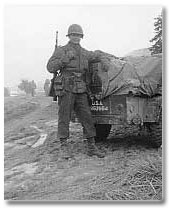
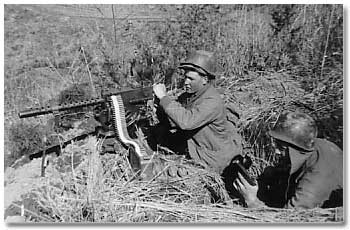 Michael Wallace Njus was born January 16, 1928, at New Hampton,
Iowa, a son of Iver and Clara Sanderson Njus. His father was a farmer and his mother was a homemaker. Mike
attended a rural grade school, and then attended and graduated from New Hampton High School in May of 1946. At age
18, he was required to register for the draft. Rather than be drafted, he decided to join the Army. His choice of
service was determined by the 18-month period of service in the Army. The Air Force, Navy, and Marines all had
longer enlistment periods. Since the draft was still going on when he graduated from high school, he was 100
percent sure he would be called, so Mike’s parents agreed with his decision to enlist for a shorter time. He
enlisted in the Army on September 23, 1946, and underwent basic training at Fort Knox, Kentucky.
Michael Wallace Njus was born January 16, 1928, at New Hampton,
Iowa, a son of Iver and Clara Sanderson Njus. His father was a farmer and his mother was a homemaker. Mike
attended a rural grade school, and then attended and graduated from New Hampton High School in May of 1946. At age
18, he was required to register for the draft. Rather than be drafted, he decided to join the Army. His choice of
service was determined by the 18-month period of service in the Army. The Air Force, Navy, and Marines all had
longer enlistment periods. Since the draft was still going on when he graduated from high school, he was 100
percent sure he would be called, so Mike’s parents agreed with his decision to enlist for a shorter time. He
enlisted in the Army on September 23, 1946, and underwent basic training at Fort Knox, Kentucky.